Is Power Cheaper at Night? This is also a super-important question, especially if you have an electric vehicle or energy-thirsty appliances.
Luckily the answer is Yes. You can use Offpeak or Night Rate electricity to in many cases significantly lower your energy cost.is a great way to save potentially a lot of money.
We show you how to check if it is a good fit for your home or business.
How does NZ use Electricity?
Peak Electricity Demand
New Zealand consumes around 40,000 GWh of electricity per year with almost two-thirds of this power is used in the North Island, according to Transpower who own and operate our national transmission grid.
The vast majority of our power is used during daylight hours. Generated by power stations, transferred around the country and consumed by our homes and businesses.
The peak period of electricity demand each year is during the colder months of June, July and August. Specifically, cold winter mornings, when we get up, boil the jug and crank the heating. This is when the national grid, generators and your local distribution company are working hard to keep up.
Typical Daily Power Consumption
The following snapshot shows a typical day in the life of New Zealand. As a whole, our lowest power usage is overnight and then peaking a few hours later mid-morning.
Our lowest power usage is overnight. Bottoming out between 4 am and 5 am each day. From there, demand quickly heats up (no pun intended) and hits the daily peak between 8 am and 10 am most days.
These peaks are caused by us cooking breakfast, making our coffee, arriving at work for the day and turning everything on.
There is typically a second, lower peak around dinner time each day and then consumption starts heading back down again.
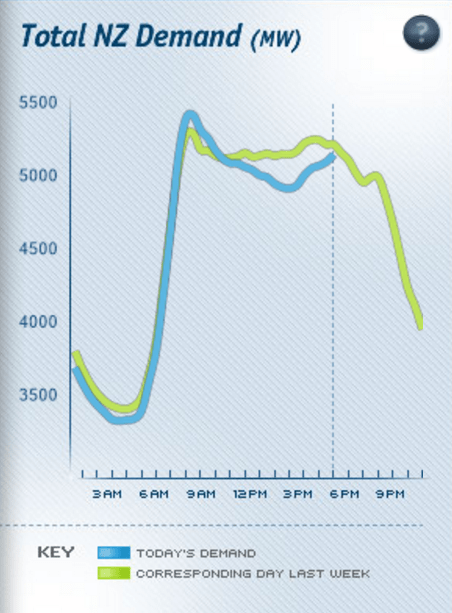
A second snapshot below shows a breakdown of the peak demand. The upper North Island demand which is dominated by Auckland and Hamilton has a relative stable electricity demand during the working day.
Comparatively the lower North Island dips during the working day before rising again for the evening peak.
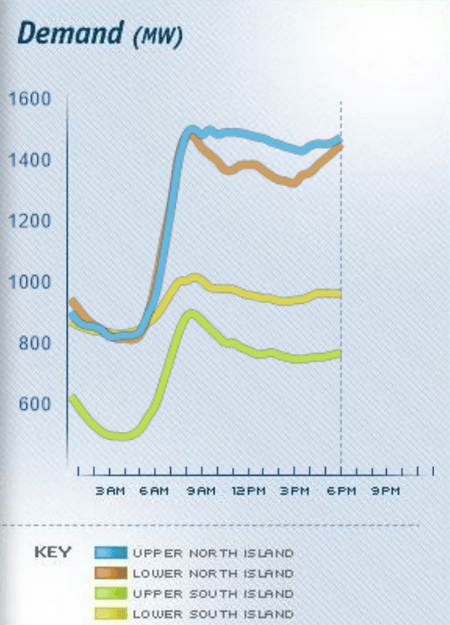
Nighttime demand
To understand how this significantly lower demand can lead to cheaper power at night, we also need to understand how the electricity network is designed and New Zealand’s generation profile.
From the Generator to You
The opportunity to get cheaper power at night stems from three components of the power industry. Power transmission, distribution and generation.
Design of a Power Distribution Network
The majority of the country’s power network is made up of transmission and distribution assets. These are the ‘poles and wires’ that carry power from the power generators, such as a hydro generator in the South Island, to your home or business which could be a load centre like Hamilton or Auckland.
When demand is the highest, on winter mornings, the transmission and distribution network is designed to carry all the electricity required to keep the country going.
So, the network is designed for the maximum demand it might see. As there would be little tolerance for the network failing on a cold winter morning.
This means at times outside of the winter mornings, the network as a whole is operating below peak demand. So there is spare capacity that is not being used, or put it another way – the network is being used inefficiently.
The Electricity Authority is advocating for distribution companies to move further towards ‘cost-reflective’ and ‘service-based’ pricing models. That is, to better reflect in their prices the cost of doing business.towards ‘price reflective’ pricing models.
A growing trend is for distribution companies to increase rates at peak load periods, and decrease rates by up to 95% at low-load periods in order to incentivise consumers to shift power from peak to off-peak.
With the increased uptake of solar power and electric vehicles, this trend will continue and New Zealanders will see an increased number of options for their power connection.
New Zealand Power Generation
For a small country, New Zealand has a large variety of power generators. From coal, gas and biomass generators to renewable geothermal power stations, hydro generators and wind farms.
A number of these fuel types are ‘base load’ generators. Which means that they prefer to run at a constant output day and night, largely irrespective of the wholesale power price. A great example is a geothermal station, which has a higher efficiency of generation at night – when the ambient temperature is cooler – and prefers to run 24/7.
Other renewable generation, such as wind farms, generate whenever the wind is present.
What I am leading to, is that overnight when power demand is significantly reduced, there is a significant portion of NZ generators that still want to operate. This will typically result in lower wholesale power pricing overnight, compared to during the day.
When you combine an under-utilised power transmission and distribution network with lower energy pricing, you get cheaper off-peak and night power.
Cost-Reflective Pricing Setups
Day Rate and Night Rate Power
There are 29 different electricity lines companies in New Zealand and unfortunately, they can all set their pricing structures differently.
Luckily most of them agree on how to define Day Rate and Night rate power.
Using our real-world Total NZ Demand chart from above, this is what Day vs Night rates look like:
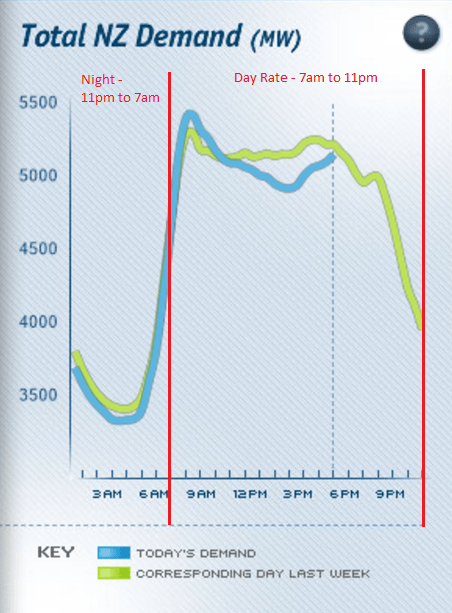
And there can be a large difference in the cost.
Example – Electra Limited
One of the most progressive distribution networks in the country for cost-reflective pricing is Electra who provides power to the Kapiti Coast and Horowhenua regions. The Electra Day and Night charges look like this at the time of writing (excl. GST):
- Day Rate: 14.25 cents per unit
- Night Rate: 1.15 cents per unit
This is simply a massive difference, and a strong incentive from the distribution company to shift your expensive daytime power to the significantly cheaper power at night. This shift from Day to Night also assists Electra to manage network loadings.
Let’s look at some of the other options that might be available, then I will explain how to access these rates.
Peak, Offpeak and Night Rate Power
The Day / Night rate is a pretty common setup and historically relied upon two separate power meters, one measuring day consumption and one measuring night consumption. This is known as a ‘two-register’ metering setup.
With the event of more modern, smarter power meters a three-register setup has become increasingly common. This uses a single meter to record usage at three different rates.
This is often referred to as ‘Peak / Offpeak / Night’, ‘Peak / Shoulder / Night’ or a ‘Triple Saver’ tariff. A practical example of how this might be set up is as follows:
Having three different periods leads to a more accurate pricing structure which is smoothed over the day.
Example – Electra Limited
Using Electra as the example again, their Triple Saver rates look like:
- Peak Rate: 18.70 cents per unit
- Off-peak Rate: 2.90 cents per unit
- Night Rate: 1.02 cents per unit
This is, in my opinion, an example of a pricing structure that is truly beneficial to both the lines company and the end user. If I was operating a business on the Kapiti Coast using a lot of power for say five hours of the workday – instead of turning on my equipment at 8 am, I could defer this until the 11 am to 5 pm ‘off-peak’ period., This would allow me to access significantly cheaper power, and assist Electa in managing their network load.
Example – Waipa Networks Limited
An example of a lines company who have recently implemented cost-reflective pricing is Waipa Networks, who cover Te Awamutu, Cambridge and surrounding areas.
The use a Peak / Offpeak / Shoulder arrangement which looks like this:
Very similar to the Electra example, but with slightly different periods for Peak and Off-peak to reflect their individual network constraints.
Hopefully, now you understand a bit more about Day / Night and Peak / Offpeak / Night rates. Now let’s see how you can access these tariffs.
Should I access Night Rate or Offpeak Power?
If you are a residential or small business consumer, very likely you are on an ‘uncontrolled’, ‘anytime’ or ‘inclusive’ tariff. This means that you get charged one rate for your power, no matter what time of day you use it.
Before accessing cheaper night rate power or off-peak power, you need to consider the following questions:
- What does my power consumption look like?
- Does my power distribution company offer a night or off-peak tariff?
- Would a move to this tariff be beneficial for me?
Let’s consider each in turn.
What does my power consumption look like?
Have a think about what your day looks like from a power perspective. When do you use lighting, heating, cooking, cooling?
As a residential consumer, with no-one at home during the day, then you are probably going to be like most kiwis and use the majority of your power during the morning and evening peaks.
If you are a business, opening up at 8 am and closing at 5 pm, then you will be using the majority of your power off-peak.
A friend of That Power Guy run’s a bakery and the ovens go on at 3 am. So she uses a lot of nighttime power.
In order to get a true understanding of your consumption, you can also go one step further and ask your power retailer for an extract of your last 24 months power usage.
Does my power distribution company offer a Night or Offpeak tariff?
The easiest way is to either ask your existing power retailer &/or your power distribution company. They will be able to let you know what’s available, and also the applicable retail rates.
Update Nov 2018: Based upon comments received on this power – if your power retailer tells you there is no day/night or peak/offpeak rate available I would suggest having a chat with your distribution lines company. They know the options in more detail, and sometimes the retailers may not be familar with the options for each area of the country.
Would a move be beneficial for me?
If you are not going to make the most of cheaper power at night and during off-peak periods, then accessing these rates is unlikely to benefit you.
Revisiting the Electra example, on an uncontrolled (‘anytime’) tariff you would pay 13.33 cents per unit + GST no matter when you use the power. If you moved to a Triple Saver tariff this would jump to 18.70. So you need to be confident you are getting the savings elsewhere.
Cheaper Power at Night and Offpeak? Let’s Do It!
If you decide to make the move, these are the steps to making the change:
Step 1a – Check Rates
I would always contact your retailer and obtain a quote for the new tariff you wish to move to. Whether it is Day / Night, Peak / Offpeak / Night or something else. They will advise the applicable retail rates.
This might also be a good time to shop around, see what rates other retailers are offering.
Step 2 – Check any Metering or Tariff Change costs
I would recommend always asking your retailer if there are any metering or tariff change fees that would apply.
If you are moving to a new two or three-register meter, then a physical meter change may be required. This may or may not incur a fee.
Fees can vary hugely from retailer to retailer. Recently I asked three retailers for meter and tariff change quotes for one of my business customers. The actual power rates were all very similar, but fees ranged from zero to $450 + GST.
Step 3 – Speak with your Electrician
If you have an old power meter or a complex metering setup then it may pay to check with your electrician before you go ahead.
In the instance of a metering contractor arriving to make a change and your existing wiring not being is not up to scratch, they may refuse to make the changes until remedial work is undertaken.
If you have a more modern home or business premises, then in my experience you are likely to be a-okay. So I would skip this step.
Step 4 – Make the Change
Once you give you power retailer the go-ahead, they will manage the meter/tariff change process. If a meter change is required, they will need to access your home or business and have a short power outage to replace the meter. If it’s only a tariff change, then this may be able to be done remotely.
Step 5 – Check, check check
Even with the most efficient business processes, you are one of around 2.1 million power consumers in NZ. Unfortunately, things can go wrong or paperwork gets lost.
Always check and double check your first two to three months of power bills to ensure that all looks okay. Especially what tariff you have been moved to, and that the rates and fees applied. Check these are the same as quoted in steps 1 and 2 above.
– TPG


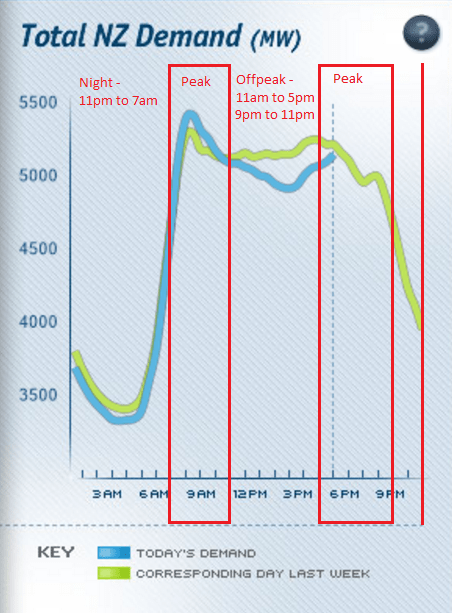
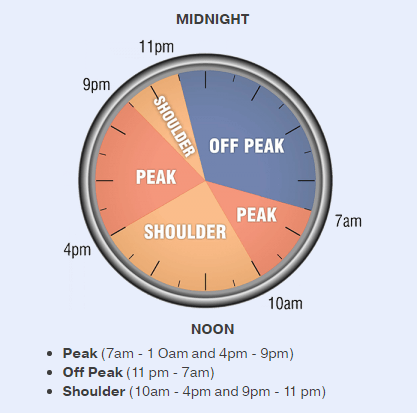
We just asked our power company (Nova Energy) to switch our hot water from Controlled to Night rate, and they told us they “no longer offer” this option, because the lines company for this area, Counties Power, refuses to offer a Night Rate option. Two Questions: (1) Are Lines Companies like Counties Power required by law to offer a Night Rate? and (2) if not, are we able to get our power from another lines company that does offer a night rate? Or is, because our home is in the Counties Power “area”, are we stuck with whatever they say?
Interesting question Jeremy! I just asked Mercury the same thing and they also said they don’t offer ‘off peak’ or night time rates. Power pricing is well stitched up and the power distributors (like the gas stations) are in it together to keep prices up.
Hi Jeremy/Christine. I have checked the Counties Power available tariffs (https://www.countiespower.com/publications) and you are correct the Day/Night and Day/Offpeak/Night tariffs are now closed to new customers. Counties are pushing customers looking for more ‘time of use’ pricing to their Smart Tariffs (https://www.countiespower.com/vdb/document/78) which offer Standard User and Low User pricing.
The Standard Smart pricing has a Weekday Peak (7am-11am, 5pm – 9pm) charge of 18.25c + GST per unit, which is quite pricey. But an Offpeak (All Weekend and Weekdays 11am – 5pm, 9pm – 7am) charge of 6.5c + GST per unit which is very reasonable. Additionally, if you have ‘controlled’ items which can be switched off at any time by Counties – e.g. hot water, pool heating etc – these are 5c + GST per unit.
So, while Nova and Mercury are correct there is strictly no ‘Night Rate’, with a bit more digging there are peak/offpeak rates available. While power retailers *should* know each rate in detail – in reality they are nationwide and have to deal with a lot of different lines companies and tariff setups. I will edit text above reflecting that another options is to speak direct with the power distribution company. Good luck! Nathan
Hi, we are in the king country lines company, they have changed from a winter peak use model (which did not include hot water since it was controlled during peak measuring) to a peak , shoulder , off peak model which is applied all year around. While their old model was slammed because one busy weekend in winter (like having family to visit) could effectively add hundreds of dollars to the annual lines charges. The new system may well work out more expensivd for many consumers, like ourselves.
Unfortunately we may have jumped out of the frypan and into the fire. Our monthly cost has dramatically increased, much of which I put down to our hotwater cylinder being able to run during any time frame including peak (25 cents a unit ). Can we ask the lines company to control our hot water to off peak times ? Or can we fit a time clock to it to ensure it only runs in off-peak (10 cents a unit)?
I have measured our general house load and of the 11 odd units a day (not a big amount ) about 4.5 are hot water and similar amount are fridges and freezer. The rest is vvery small. I am reluctant to time control the fridge and freezer incase temperature rise , what are your thoughts on this ?
My calculation is approximately $250 a year saving over our new charges, ironically about what we paid before the change !
Hi William. I have looked up The Lines Company (“TLC”) tariffs from 1 October 2018. They now have Peak (7:00am-9:30am, 5:30pm-8:00pm), Shoulder (9:30am-5:30pm, 8:00pm-11:00pm) and Offpeak (11:00pm – 7:00am) power usage periods.
From your message, looks like you are on the Uncontrolled, High Density Area, Low User tariff. So your pricing is approx Peak 24c/unit, Shoulder 16c/unit, Offpeak 10c/unit.
Interestingly, looking at the Controlled tariff pricing –> the Controlled Peak pricing (17c/unit) is cheaper than Uncontrolled Peak (24c/unit) with Shoulder and Offpeak identical. It also looks like if you are Controlled, then all of your Peak power is at the cheaper rate not just the water heating. This is a common tactic to encourage people to go controlled. But I would double check this with TLC, as it’s also possible only the controlled portion of your load is at the lower rate (which is of significantly less benefit).
If I was in your shoes, my strategy would be as follows:
1) Ask The Lines Company to move you onto a Controlled tariff and ripple control your water heating. This is in their best interests, so hopefully there is no charge to make this change.
2) THEN I would get your electrician to add a timer that you control to your hot water heater and set this to only turn on overnight/offpeak.
This is getting a double benefit – lower pricing for all your peak power (fridge etc as well), plus your water heating is at the cheapest rate.
You *could* go a step further and put a timer on your deep freeze and maybe fridge. I am confident the freezer wouldn’t get any warmer during the short 2.5 hour peak periods. BUT if you manage to get whole house on controlled tariff – then in reality the difference between Controlled Peak and Controlled Shoulder is only 1c/unit… so maybe not worth the effort or inconvenience.
Hope this makes sense. Good luck with lowering your bill!
Cheers, Nathan
Thanks, I know we were on a controlled supply under the old system so I will make enquiries about that. It is a tricky bit of floor with it being a moving feast as they say. If everyone makes changes to cut their bills I am sure a new tariff system will be implement , being the cynic I am. But your advice is very well appreciated.
Electric Kiwi is the only one that seems to have some sort of off peak mechanism and is good if you can maximise their free power hour! Any hour except 5PM-9PM and you can change it on a daily basis.
Might need a bit of adjustments to certain routines like shower and washing, ironing but it adds up.
So I’ve been looking into this recently as we use a lot of our power overnight so getting the cheaper night rate makes sense.
Im in Christchurch and Genesis and Meridian offer night rates it seems but they say my smart meter is “all inclusive” so it can’t be split into day/night. I could get a meter change for around $180 Genesis quoted.
However, Flick electric on their Fixie plan also offer day/night rates and they do not require any special meter because I believe it works off them being sent usage data every 30 minutes by the smart meter?
So my question then is why can’t other retailers offer the same service as Flick? Are there any cheaper options to get my meter changed if I wanted to so that I could use the Meridian/Genesis offer?
It boggles my mind that retailers can get away not offering the day/night rates as an option because with heat pumps and central heating becoming more and more of an issue often people will find their usage overnight more than justifies the night rate.
Especially considering that the off peak in Christchurch includes ALL WEEKEND!
I believe that alone would mean over the course of a week the larger percentage of people would be better off on day/night or off peak rates would it not?
Hi Brendan – Great question!
My experience has been that these kind of issues are due to system restrictions with the larger more established power companies. I.e. Their data capture and billing systems are not modern enough to cope with 30 minute data. This is what I would guess is the issue. The meter change (it may not be a change, but an update/reconfiguration of the same meter – depends on the meter) is to compensate for the system restrictions.
Here’s an example: Let’s saw you have a modern, cost effective smart meter with a single ‘register’ (or memory slot) in which to save your power comsumption. Each day, it records your half hourly power consumption in its memory (the single register) and then sends it to the power company shortly after midnight each day. The data it sends is 48 x half hourly readings.
Flick can handle this data in it’s native format. Flick stores each of the 48 readings in their database and then calculate your peak and offpeak usage. They then bill based upon this data. Easy for them, as they are dealing with 30 minute data for every user.
Genesis (hey I’ll pick on Genesis, but other companies have similar issues) have a system that was designed prior to 30-minute pricing being an option, so their system can’t natively store the 48 readings your meter provides. The only way they can do it is to add them all together and store one number per register, per day.
Even though your smart meter provides the same data to both Flick and Genesis, Genesis can’t handle it (yet). The workaround for Genesis is that they install a multi-register meter. This meter is set up so that daytime power usage is recorded in Register 1, night time in Register 2. Genesis can process data from two different registers, therefore you can now have day and night rate! Voila! Unfortunately, this can mean a cost for the meter change (or sometimes they can just change the settings in your meter to accommodate 2 x rates).
I have done this a load of times for commercial customers (in particular on the Kapiti Coast) where the cost of the meter change to enable Peak/Offpeak/Night is very small compared to the savings this allows. It’s a pain, but sometimes worth it.
I hope this makes sense and helps? My recommendation would be to run the numbers and if it’s worthwhile changing the meter, just suck it up and do it. If it’s not – it’s not. If you do get the meter changed, try to get a smart meter to replace the existing one – this keeps the option open to use Flick (or similar) in the future. This sounds common sense, but sometimes power companies will install an old school non-smart meter so best to ask.
It sounds like you’re on the path to cheaper power – awesome and good luck!
I have been looking at solar with a battery option.
Would you be able to tell your battery (assuming available software) to fully charge at night rates, and just skip the solar, or are the power companies wise to and against his idea?
With the right controller you can do anything. This is are businesses built around this model with large grid-connected batteries – charge at low rates / ‘generate’ onto the grid at peak rates. Rinse and repeat.
Hi
We’ve just installed a Tesla Powerwall, have 6.6kW of solar pv on our roof, are grid-tied with Pioneer/Pulse. Looking for a new supplier that allows cheap night rates, and will buy my surplus. Is there such a supplier?
Does WEL Mercury still have night or off-peak tariffs?